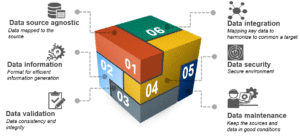During my digital transformation journey together with our customers, I receive a lot of questions. Currently, I have encountered a new challenge:
“How can I trust my data?”
The question from our customers is simple and extremely significant. With the introduction of new technology like Machine Learning (ML) and in the long term Artificial Intelligence (AI), we become more and more dependent on our process data.
How do we know if the collected process data is correct? What if there is some measuring error? Some inaccuracies in the measurement? Did we really collect all the data? Once it is in the “system”, the data is often considered as true and is not validated anymore.
An alternative wording of trust is integrity, to be more specific data integrity. Data integrity refers to the completeness, accuracy, and consistency of data. It is already key in the pharmaceutical industry to ensure that the end products meet the required quality standards. Data integrity is rather new for the process industry but as mentioned before increasingly more important.
The Validation of Process Data
The validation of process data starts at the measurement device. The reliability and integrity of the measurement data can be increased by
- Option Number 1: Using multiple sensors for the same measurement or
- Option Number 2: Using proactively sensor diagnostics.
Multiple Sensors
Traditional, multiple sensors are often not an option due to financial constraints. Unless it concerns safety, companies do not decide to buy multiple sensors for measurement. The reason for this decision is simple: A transmitter (costs: 500 Euro) wired, connected, configured in the control system and making available for different users, ends in a total bill of 5000,- Euro or even higher.
But there is a game changer around the corner. Increasing the reliability of measurement data will change with the introduction of the Industrial Internet of Things (IIoT) devices with easy installation and connection. How will the future situation look like? Just imagine that all manometers are replaced by IIoT devices and connected via LoRaWAN to the Cloud and are directly available for users. This way data can easily be verified by means of multiple measurements in a cost-effective manner.
Sensor diagnostics
The existing alternative is proactive maintenance. The technology to support proactive maintenance is already available for a long time, especially after the introduction of Device Type Manager (DTM) / Field Device Technology (FDT). However, the change from preventive maintenance to proactive maintenance is a cultural change and not a technical change. I have seen many companies purchasing asset maintenance systems in order to have access to the DTM of field devices, but I have seen only a few companies who have been able to make the real cultural change and using the asset maintenance systems proactively. It is my firm believe that proactive maintenance is the future because of reliability management, safety management and of course data integrity.
Once a field device shows an error, the process control system will still collect the data and forward the data to the data historian system. Once the data is in the data historian system, it becomes more difficult to validate data integrity. This can be partially solved by means of a quality flag. In the control system, the data conditions bad, suspicious or good can be defined. Data out of range can be considered as bad, data with certain alarms can be considered as suspicious and else the data is considered as good. This quality flag can be added to every data transfer in order to validate the data in the data historian system.
Production Accounting
A third option to validate the data integrity at sensor level is production accounting or also called yield accounting. At the heart of these systems, there is a mass balance model comprised of nodes and connections that represent the entire site including process units, storage tanks and all the streams that are part of the product movements. The inputs to the production accounting system come automatically from several sources, such as process control systems, data historian systems, laboratory information management system and automated tank gauging. Once all data is in the system, by means of a model and sophisticated mathematical routines, imbalances of mass can be detected. In most cases, these imbalances refer to wrong or inaccurate measurements. If the production accounting system is used daily, maintenance will receive daily instructions with respect to field devices causing possible wrong measurement. Calibration or repair of these field devices results in more accurate measurements which of course increase the data integrity.
Data Integrity needs a Mind Shift
Although data integrity has been around for a long time, it has gained more importance due to the use of data for multiple purposes. The technology to increase the data integrity is available, now only the culture must change to make it happen. Do you feel ready for the change?





